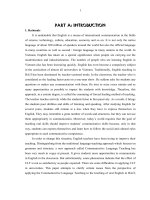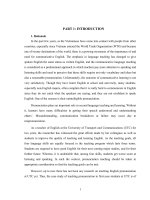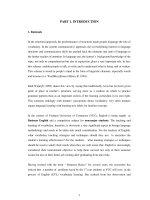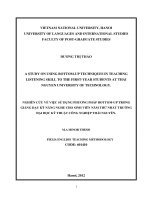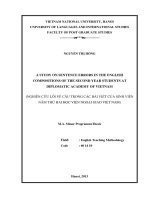Student’s attitudes towards the integrated approach to grammar teaching, a quasi-experimental research on the first year students at hanoi college of economics andtechnology
Bạn đang xem bản rút gọn của tài liệu. Xem và tải ngay bản đầy đủ của tài liệu tại đây (1.98 MB, 11 trang )
student’s attitudes towards the integrated
approach to grammar teaching, a quasi-
experimental research on the first year students
at hanoi college of economics andtechnology
Phương Pháp Tích Hợp
Vũ Thị Sâm
Trường Đại học Ngoại Ngữ
Luận văn ThS. Chuyên ngành: English Teaching Methodology; Mã Số: 60 14 10
Người hướng dẫn: Dr. Duong Thi Nu
Năm bảo vệ: 2010
Abstract: As at the center of concern of any EFL teachers, grammar plays a crucial role to
English teaching and learning. However, due to some institutional constraints, grammar teaching
at the Hanoi College of Economics and Technologies requires more than the application of one
method to get the best result. At the college, where most of the teachers prefer traditional
approach to teach grammar, students seem not interested in learning and show negative attitudes
towards the teaching approach as well as toward their grammar learning. This study is therefore
conducted with the hope to find out whether the integration of different teaching approaches
helps students change their attitudes towards grammar learning.So as to reach that aim, the
author conducted a quasi-experiment in 6 weeks with the hypothesis that the integrated teaching
approach can change student’s attitudes towards grammar learning. The data was collected from
pre and post treatment questionnaires and structured interviews. Findings showed that there was
a positive change in student’s attitudes towards grammar learning after 6 weeks of the
experiment. Students vowed that they got better absorption of grammar rules because of more
creative and motivating class atmosphere and learning procedure thanks to the flexible
application of integrated teaching approach. Based on the findings of the study, some
recommendations were derived for the application of the integrated approach to grammar
teaching to low level students of English. It is hoped by the author that this small study will
provide an effective and interesting way to teach and to learn grammar to teachers and students
at her context in particular and in other similar teaching environments in general.
Keywords: Tiếng Anh; Phương pháp dạy học; Ngữ pháp
Content:
iv
TABLE OF CONTENTS
DECLARATION
i
ACKNOWLEDGEMENT
ii
ABSTRACT
iii
TABLE OF CONTENTS
iv
LIST OF ABBREVIATIONS
v
PART 1: INTRODUCTION
1. Rational
2. Aims of the Study
3. Research questions
4. Scope of the Study
5. Method of the Study
6. Organization of the Study
1
1
2
2
3
3
3
PART 2: DEVELOPMENT
Chapter 1: LITERATURE REVIEW
1.1. Learning attitudes
1.1.1 Definitions of learning attitudes
1.1.2 The role of attitudes in language learning
1.2. Theoretical background of grammar teaching
1.2.1 Definitions of grammar and the place of grammar in English
language teaching
1.2.2 The brief view of grammar teaching approaches
1.2.3 Stages of a grammar lesson at the current trend of ELT
1.3 Rational for the Integrated Approach
1.3.1. There is no best method
1.3.2. Related studies
1.3.3. Institutional reasons for the integrated approach
5
5
5
5
5
6
6
8
12
13
13
13
14
v
1.3.3.1 Low level students
1.3.3.2 Large-size and mixed level class
1.3.3.3 Student’s specific learning needs
1.3.4 Practical suggestions for the application of integrated approach
1.4 Conclusion to the chapter
Chapter II: METHODOLOGY
2.1 The context of the study
2.2 Study design
2.3 Research questions
2.4 The participants
2.5 Data collection instruments
2.5.1 The questionnaires
2.5.2 The interviews
2.6 Data collection procedure
15
15
16
17
18
19
19
20
20
20
21
21
21
Chapter III: ANALYSIS, FINDINGS AND DISCUSSIONS
3. 1. Data analysis
3.2. Findings and discussions
3.2.1. Teachers’ beliefs and knowledge in teaching pronunciation
3.2.2. Formal curricula description
3.2.3. Teaching pronunciation’s goal and assessment
3.2.4. Approaches and techniques of teaching pronunciation
3.2.5. Teachers’ roles in teaching pronunciation
3.3.6. Teaching and learning materials
23
23
23
23
23
29
32
34
35
PART 3: CONCLUSIONS AND IMPLICATIONS
3.1 Summary of major findings
3.2 Implications of the Study for Teaching pronunciation
3.2.1 Improving teacher’s knowledge and opinion of different approaches to
TEFL
3.2.2 Enhancing and varying teacher’s roles in teaching
32
32
33
33
34
vi
3.2.3 Not to depreciate the appropriate uses of L1 in the classroom
3.2.4 Some suggestions for the integration of approaches in grammar
teaching
3.2.5 Improving Facilities and Teaching/Learning Environment
Conclusion to the chapter
4 Limitations of the Study
5 Suggestions for further research
35
36
38
38
39
40
REFERENCES
41
APPENDICES
APPENDIX A Pre-treatment questionnaire
APPENDIX B Post-treatment questionnaire
APPENDIX C Pre-treatment interview and discussion
APPENDIX D: Post-treatment interview and discussion
APPENDIX E: List of tables
I
I
V
VII
VIII
IX
1
PART 1: INTRODUCTION
1.1 Rational
Teaching and learning grammar has been regarded as crucial to the ability to use a
language. In other words, grammar gains a prominence in language teaching, as much as
without a good knowledge of grammar, learners’ language development will be severely
constrained. By studying grammar learners come to recognize the structure and regularity
which is the foundation of language and they gain the tools to talk about the language system
(Burns and de Silva Joyce, 1999, p.4-5). This is undeniable, and can be strongly agreed by any
ESL teachers, who have paid much attention to teaching grammar in their classroom. It is
clear for all that, by teaching grammar, teachers not only offer learners the means to express
themselves but also fulfill learners’ expectations of what learning a foreign language involves.
However, how to teach grammar effectively is not easy at all. This is the big concern
of any language teachers, especially those who teach English to students with practical
purposes of communication and work in the future. As a teacher at a newly born college as the
Hanoi College of Economics and Technology (hereafter in referred as Hanetco), where
English is considered the most dominant and essential subject, the researcher and all of her
colleagues at the college have the absolute consensus that grammar is something that needs
putting to the top of priority. Unfortunately, we found that there are many constraints,
regarding institutional, learner perspectives, and teaching context perspective, that prevent us
from teaching English grammar best communicatively. Moreover, as referred from well-
known linguists, the author has an idea that many of the approaches to grammar teaching,
currently popular or has been waned, all have the advantages and availability and suitability to
be utilized in different teaching situations. That is why in this small research, the researcher
tries to make a suggestion of an integrated approach to teaching grammar to students at
Hanetco.
Learning attitudes has recently received considerable attention from both first and
second language researchers. Most of the researches on the issue have concluded that learner’s
attitude is an integral part of learning, and that should be, therefore, become an essential
component of second language learning pedagogy. There are several reasons why research on
2
student’s attitudes towards language learning is important. First, attitudes towards learning are
believed to influence behaviors (Kaballa & Crowley: 1985) (Source: Weinberg 1998) such as
selecting and reading books, speaking in a foreign language. Second, a relationship between
attitudes and achievements has been shown to exist. Schibeci and Riley (1986), (Source:
Weinberg 1998) report that there is support for the proposition that attitudes influence
achievement, rather than achievement influencing attitudes. The reason is that attitudes
influence one’s behaviors, inner mood and therefore learning. So it is clear that there is an
interaction between language learning and the environmental components in which students
grew up. Both negative and positive attitudes have a strong impact on the success of language
learning. The attitudes of an individual depend heavily upon different stimuli. Stern (1983)
claims that the affective component contributes at least as much and more often to language
learning than the cognitive skills, and this is supported by recent researches. All studies
adduce that affective variables have significant influences on language success (Eveyik, 1999;
Skehan, 1989; Gardner, 1985; Spolsky, 1989). Discovering student’s attitudes about language
will help both teacher and learner in the teaching-learning process. Therefore, we have to
consider the crucial role of this affective domain, attitudes.
1.2 Aims of the study
The aim of the study was to investigate what the attitudes of the students at Hanetco
towards English grammar learning are and how their attitudes would change after some
grammar lectures with the integrated approach. Thanks to the findings of the study, the
researcher hopes to leave some suggestions for further study in this very interesting topic.
1.3 Research questions
Focusing on a case with a target on the first year non-English-major students at
Hanetco, this research examined the learning of grammar before and after the experiment of
the integration of approaches. To achieve this, three research questions were proposed:
(1) What are the reasons for a change in approach to grammar teaching to students at
Hanetco?
(2) What are students’ expectations towards grammar teaching and learning?
(3) What are the students’ attitudes towards the new integrated approach?
3
(4) 1.4. Scope of the Study
This study plays the role as a quasi-experimental study. Due to the time limit and
financial constraint, the author was unable to carry out the experimental study on a larger
scale. Therefore, the researcher intends to describe the student’s attitudes and beliefs towards
English learning and teaching in the real context of first-year students at Hanetco.
1.5. Method of the Study
A qualitative and quantitative methodology was selected for this quasi-experimental
research. This involves the following instruments for data collection:
(1) Survey questionnaires (pre-experiment and post-experiment questionnaire)
(2) Interviews and discussions
The collected data come from 138 first year students, gathering in two groups of
banking faculty, interviews and discussions with random students. Then the analysis is carried
out in the light of finding out the answers to the research questions and the interviews.
1.6. Organization of the study
The study includes three parts:
- Part 1, INTRODUCTION, introduces the rational for the research, the aims of the study, the
scope, the methods and the organization of the study. This part also provides a brief
description of the thesis topic and information related to English grammar teaching and
learning at the author’s teaching context, which is background of the study.
- Part 2, DEVELOPMENT, consists of three chapters as follows:
- Chapter 1: LITERATURE REVIEW
This part offers the reviews of literature related to studies on learning attitudes, the
effect of attitudes on learning result, as well as the brief description of English grammar
teaching histories together with the sketchy analysis of some popular approaches to grammar
teaching. Those help to provide the rational for the supposed integrated approach.
- Chapter 2: METHODOLOGY
4
The actual procedures of the study are presented in this part: study design, subject of
the study, data collection instruments as well as data collection analyzing process.
- Chapter 3: ANALYSIS, FINDINGS AND DISCUSSIONS
This part focuses on presenting, analyzing and discussing the results obtained from the study.
- Part 3, CONCLUSIONS AND RECOMMENDATIONS, summarizes some major
findings, provides recommendations for a possibly applicable approach to teaching grammar,
limitations of the study, and suggestions for further research.
41
REFERENCES
1. Atkinson, D. 1987. The mother tongue in the classroom: A neglected resource? ETL
Journal, 41, 4, pp. 241–247.
2. Brown H. Douglas (1994) Principle of Language Learning and Teaching. Prentice
Hall. Inc. Englewood Cliffs. New Jersey 07632
3. Burn, A. & de Silva Joyce, H. (1999): Focus on Grammar. Sydney. NCELTR
4. Canale, M. and Swain, M. (1980) Theoretical Base of Communicative Approaches to
5. Celce-Murcia, M (1988). Techniques and Resources in Teaching Grammar. Oxford
University Press
6. Clement R. Smythe, P.C, & Gardner R.C (1976) Attitudes and Motivation Scales
related to the learning of English as the second language. Canadian Modern Language
Review
7. Ellis, Rod. (2001). Second Language Acquisition: The Role of Consciousness. Lecture
given at National Chengchi University, Taiwan.
Available:
8. Fromkin V et al (1990). An Introduction to Language (2
nd
ed.) Sydney Holt,
Rinerhart& Winston
9. Gardner, R.C. Social Psychology and Language Learning: the role of attitudes and
motivation. London: Edward Arnold
10. Gardner, R.C, Lamper, W.E (1972). Attitudes and Motivation in Second Language
Learning. Rowley. MA: Newbury House
11. Giao, Nguyen Quynh, and Hoa, Nguyen Thi Nhan 2004. Applying Communicative
Methods to Teach Grammar: An Experiment. Teacher’s Edition, 14, p. 16 - 25
12. Goner, Phillips, and Walters. Teaching Practice Handbook: Structures: Grammar and
Function. Heinemann, 1995. 129-138.
13. Gibb, M.(1988) A Comparative Study of Attitudes towards Variety of English held by
Professional and Tertiary Level Students in Korea
42
14. Hallorah, J.D. (1967) Attitudes Formation and Change. Great Britain: Leicester
University Press
15. Harmer, J. 1987. Teaching and Learning Grammar. Longman Group UK Limited
16. Hendrickson, A.B (1997). Predicting Students’ Success with the Learning and
Strategies Inventory (LASSI). Iowa State University
17. Jack C. Richards and Theodore S. Rogers (2001). Approaches and Methodologies in
Language Teaching. Cambridge. Cambridge University Press
18. Jeremy Harmer (1991). The Practice of English Language Teaching. Essex England;
Longman Group UK Limited
19. Krashen S.D 1982.Principles and Practice in Second Language Acquisition. Oxford:
Pergamon Press
20. Larsen-Freeman, D. (1986). Techniques and principles in language teaching. Oxford:
Oxford University Press.
21. Lightbown, P.M and Spada, N.1999. How Languages are Learned (Revised Ed).
Oxford: Oxford University Press.
22. Marzano R.J. et al (1994). Assessing Student’s Outcome: Performance Assessment
Using the Dimensions of Learning. Virginia Alexandria: Association for Supervision
and Curriculum Development.
23. Musumeci, D. 1997. Breaking the tradition: an exploration of the historical
relationship between theory and practice in second language teaching. N.Y.:
McGraw-Hill.
24. N.S Prahu. There is no best method – why?: TESOL Quarterly, Vol.24, No.2 (Summer
1990), p.161 – 176
25. Nunan D. (2003). Practical English Language Teaching Higher Education Press
26. Penny Ur (1988). Grammar Practice Activities: A Practical Guide for Teachers.
Cambridge. Handbook for Language Teachers
27. Richards, J.C, Platt, J and Platt, H (1992). Longman Dictionary of Language Teaching
and Applied Linguistics (2
nd
ed.) England: Longman
28. Rice, J.M. (1902). Educational research: A test in arithmetic. The Forum, 34. 281-297.
In Cram, B.
43
29. Rivers, Wilga M., Temperley, Mary S. A Practical Guide to the Teaching of English as
a Second or Foreign Language. Oxford University Press, 1978. 110.
30. River W. (1981). Teaching Foreign Language Skill. University of Chicago Press
31. Swain, M., & Canale, M. (1982). The role of grammar in a communicative approach
to second language teaching and testing. (EDRS No. ED 221 026, 8 pages) (not
available separately; available from EDRS as part of ED 221 023, 138 pages)
32. Stern, H. H. (1983). Fundamental Concepts of Language Teaching. Oxford: Oxford
University Press)
33. Sato K. (2003) Improving out Students’ Speaking Skill: Using Selective Error
Corrections to Reduce Anxiety and Encourage Real Communication
34. Smart G.D (2006) The Brighter Slide of Teaching Large Multilevel Classes.
Cambridge University Press
35. Stern H.H (1983) Fundamental Concepts of Language Teaching. Oxford: Oxford
University Press
36. W. M. Rivers, Teaching Foreign-Language Skills . 2d ed. (Chicago: University of
Chicago Press, 1981
37. Zakia Sawar. Adapting Individualization Techniques for Large Class. Innovation in
ELT, ed. Hall David and Anne Hewing (London: Routeledge 2001, 127 - 136)
38.
39.
